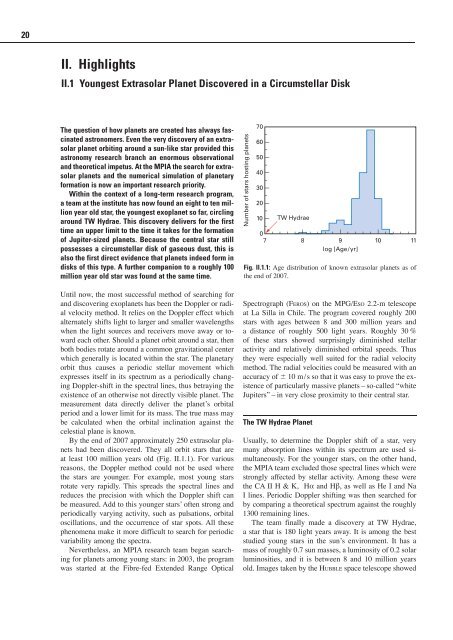Max Planck Institute for Astronomy - Annual Report 2007
Max Planck Institute for Astronomy - Annual Report 2007
Max Planck Institute for Astronomy - Annual Report 2007
Create successful ePaper yourself
Turn your PDF publications into a flip-book with our unique Google optimized e-Paper software.
20<br />
II. Highlights<br />
II.1 Youngest Extrasolar Planet Discovered in a Circumstellar Disk<br />
The question of how planets are created has always fascinated<br />
astronomers. Even the very discovery of an extrasolar<br />
planet orbiting around a sun-like star provided this<br />
astronomy research branch an enormous observational<br />
and theoretical impetus. At the MPIA the search <strong>for</strong> extrasolar<br />
planets and the numerical simulation of planetary<br />
<strong>for</strong>mation is now an important research priority.<br />
Within the context of a long-term research program,<br />
a team at the institute has now found an eight to ten million<br />
year old star, the youngest exoplanet so far, circling<br />
around TW Hydrae. This discovery delivers <strong>for</strong> the first<br />
time an upper limit to the time it takes <strong>for</strong> the <strong>for</strong>mation<br />
of Jupiter-sized planets. Because the central star still<br />
possesses a circumstellar disk of gaseous dust, this is<br />
also the first direct evidence that planets indeed <strong>for</strong>m in<br />
disks of this type. A further companion to a roughly 100<br />
million year old star was found at the same time.<br />
Until now, the most successful method of searching <strong>for</strong><br />
and discovering exoplanets has been the Doppler or radial<br />
velocity method. It relies on the Doppler effect which<br />
alternately shifts light to larger and smaller wavelengths<br />
when the light sources and receivers move away or toward<br />
each other. Should a planet orbit around a star, then<br />
both bodies rotate around a common gravitational center<br />
which generally is located within the star. The planetary<br />
orbit thus causes a periodic stellar movement which<br />
expresses itself in its spectrum as a periodically changing<br />
Doppler-shift in the spectral lines, thus betraying the<br />
existence of an otherwise not directly visible planet. The<br />
measurement data directly deliver the planet’s orbital<br />
period and a lower limit <strong>for</strong> its mass. The true mass may<br />
be calculated when the orbital inclination against the<br />
celestial plane is known.<br />
By the end of <strong>2007</strong> approximately 250 extrasolar planets<br />
had been discovered. They all orbit stars that are<br />
at least 100 million years old (Fig. II.1.1). For various<br />
reasons, the Doppler method could not be used where<br />
the stars are younger. For example, most young stars<br />
rotate very rapidly. This spreads the spectral lines and<br />
reduces the precision with which the Doppler shift can<br />
be measured. Add to this younger stars’ often strong and<br />
periodically varying activity, such as pulsations, orbital<br />
oscillations, and the occurrence of star spots. All these<br />
phenomena make it more difficult to search <strong>for</strong> periodic<br />
variability among the spectra.<br />
Nevertheless, an MPIA research team began searching<br />
<strong>for</strong> planets among young stars: in 2003, the program<br />
was started at the Fibre-fed Extended Range Optical<br />
Number of stars hosting planets<br />
70<br />
60<br />
50<br />
40<br />
30<br />
20<br />
10<br />
0<br />
7<br />
TW Hydrae<br />
Fig. II.1.1: Age distribution of known extrasolar planets as of<br />
the end of <strong>2007</strong>.<br />
Spectrograph (Fe r O s) on the MPG/esO 2.2-m telescope<br />
at La Silla in Chile. The program covered roughly 200<br />
stars with ages between 8 and 300 million years and<br />
a distance of roughly 500 light years. Roughly 30 %<br />
of these stars showed surprisingly diminished stellar<br />
activity and relatively diminished orbital speeds. Thus<br />
they were especially well suited <strong>for</strong> the radial velocity<br />
method. The radial velocities could be measured with an<br />
accuracy of 10 m/s so that it was easy to prove the existence<br />
of particularly massive planets – so-called “white<br />
Jupiters” – in very close proximity to their central star.<br />
The TW Hydrae Planet<br />
8 9<br />
log [Age/yr]<br />
10 11<br />
Usually, to determine the Doppler shift of a star, very<br />
many absorption lines within its spectrum are used simultaneously.<br />
For the younger stars, on the other hand,<br />
the MPIA team excluded those spectral lines which were<br />
strongly affected by stellar activity. Among these were<br />
the CA II H & K, Ha and Hb, as well as He I and Na<br />
I lines. Periodic Doppler shifting was then searched <strong>for</strong><br />
by comparing a theoretical spectrum against the roughly<br />
1300 remaining lines.<br />
The team finally made a discovery at TW Hydrae,<br />
a star that is 180 light years away. It is among the best<br />
studied young stars in the sun’s environment. It has a<br />
mass of roughly 0.7 sun masses, a luminosity of 0.2 solar<br />
luminosities, and it is between 8 and 10 million years<br />
old. Images taken by the Hu b b l e space telescope showed

















